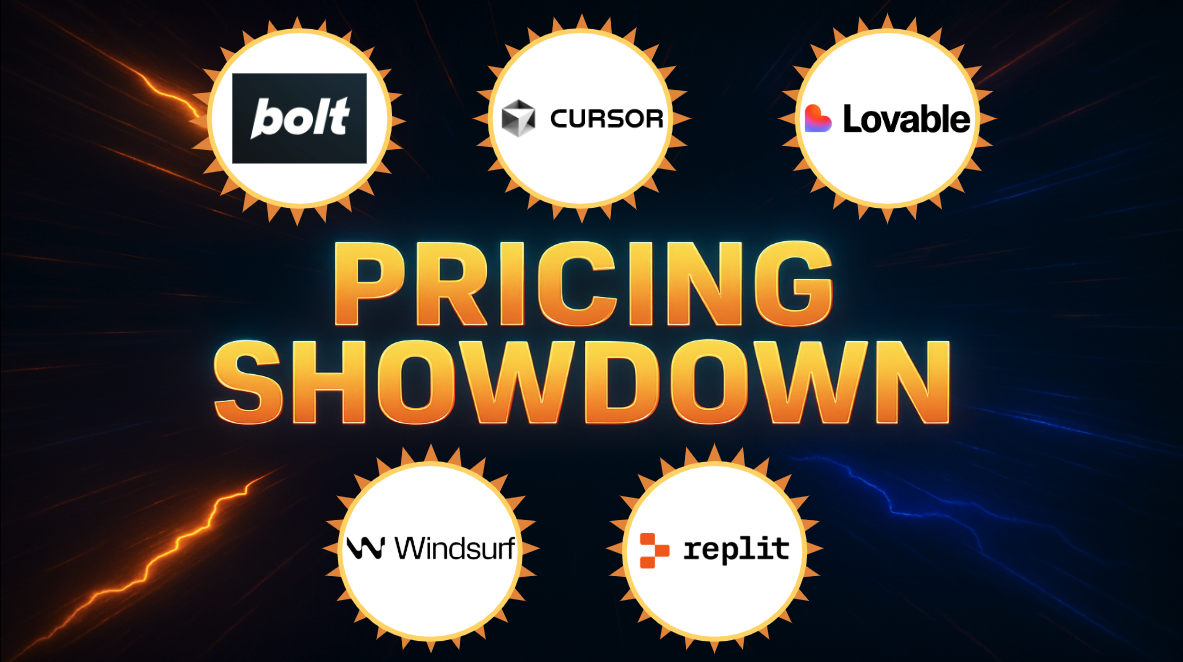The AI coding platform market is experiencing unprecedented growth, with companies achieving massive revenue milestones at breakneck speed. Traditional business metrics can barely keep up with this explosive expansion. Today, we're diving deep into the SaaS pricing models and AI pricing strategies of five AI coding platforms that are reshaping the tech landscape: Replit, Cursor, Windsurf, Lovable, and Bold.
The Market Leaders: Explosive Growth Stories
Replit: The Education Pioneer Turned AI Powerhouse
Founded in 2016, Replit has transformed from an educational coding platform into an AI development juggernaut. According to their CEO, Replit skyrocketed from just $10 million in ARR at the end of 2024 to $100 million in ARR by June 2025, achieving 10x growth in under six months. With 22.5 million users and backing from heavyweights like Andreessen Horowitz and Kleiner Ventures, Replit has established itself as a veteran player in this space.
Cursor: The Speed Demon
If Replit's growth is impressive, Cursor's trajectory is simply mind-boggling. This MIT-born startup has achieved what many consider impossible: becoming the fastest SaaS company ever to reach $100 million in ARR, accomplishing this feat in just 12 months. With over $500 million in ARR and more than 360,000 paying customers out of their total 1 million user pool, Cursor has captured the hearts and wallets of developers worldwide.
Windsurf: The Enterprise Challenger
Enter Windsurf, formerly known as Codeium. While not matching Cursor's astronomical growth, Windsurf has carved out its own impressive path. In May 2025, OpenAI acquired Windsurf for approximately $3 billion, making it OpenAI's largest acquisition to date. Before the acquisition, Windsurf had reached $40 million in ARR, serving over a thousand enterprise customers, including Dell and Zillow.
Lovable: Europe's Rising Star
From Stockholm comes Lovable, proving that Silicon Valley doesn't have a monopoly on AI innovation. This Swedish startup has achieved what many call the fastest growth in European startup history. Launching their first product in late 2024, they hit $50 million ARR in just six months. With 25,000 new apps being built daily on their platform and 30,000 paying customers, Lovable is making "no-code" more than a buzzword.
Bolt: The Pivot Success Story
Bolt perhaps has the most dramatic success story of them all. Parent company StackBlitz was reportedly on the brink of running out of cash just five months before Bold's launch. Today, they've raised $105 million at a $700 million valuation, with ARR skyrocketing to $20 million within two months of launch and reportedly now approaching $40 million, attracting nearly 1 billion users per month.
The SaaS Pricing Analysis Framework
To evaluate these companies' AI pricing models and SaaS pricing strategies, I analyzed three critical dimensions:
1. Packaging
How well do the packages cater to the full spectrum of customer segmentation? Great SaaS pricing models should be a perfect glove fit with customer segments, not randomly created without market understanding. Companies need to understand what enterprises actually need in terms of workflow and security capabilities, not just slap an "enterprise" label on a basic plan.
2. Pricing Metric
Is the pricing metric aligned with customer success? Whether companies choose per-token, per-credit, or other AI pricing models, the metric should be simplified for customers. Most customers don't inherently understand what a credit or token means, they know what work they need to accomplish. Companies must translate technical metrics into business value.
3. Price Points
A good spread of price points prevents cannibalization while maximizing revenue. If price points are too close, plans cannibalize each other. If they're not high enough, money is left on the table. Freemium SaaS pricing models that give away too much can knee-cap revenue potential.
Individual Company Analysis
Lovable: Clean but Limited
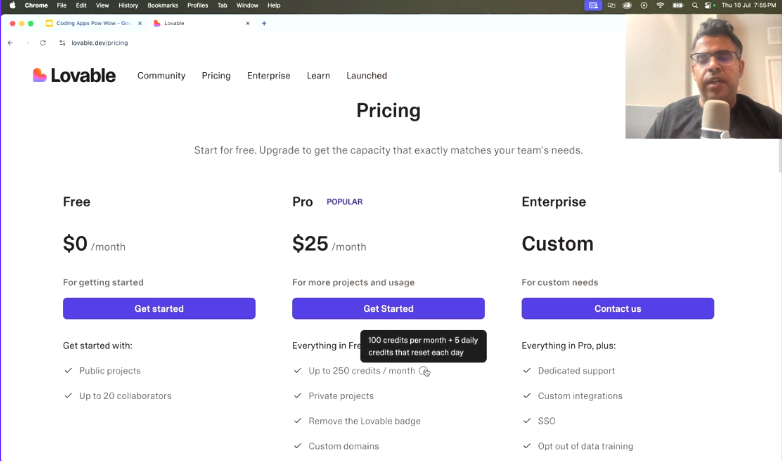
Packaging (5/10): Lovable offers three main plans: Free (up to 20 collaborators), Pro ($25/month), and Enterprise. The pricing is clean and easy to understand, but they're missing crucial middle-tier options. Serious developers have only two real choices, Pro or Enterprise, which creates unnecessary friction in the sales process.
Pricing Metric (6/10): Lovable uses a credit-based system with 250 credits per month on the Pro plan, plus 5 daily credits. While they provide examples (simple message = 0.8 credits, complex message with multiple file operations = 2.4 credits), newcomers still struggle to understand what constitutes a "message" in practical terms.
Price Points (5/10): The limited plan structure leaves significant money on the table. Companies like ElevenLabs successfully offer price points up to $1,300 with 6-7 plans. Lovable's lack of segmentation creates longer sales cycles and missed revenue opportunities.
Bolt: Solid Foundation with Room for Growth
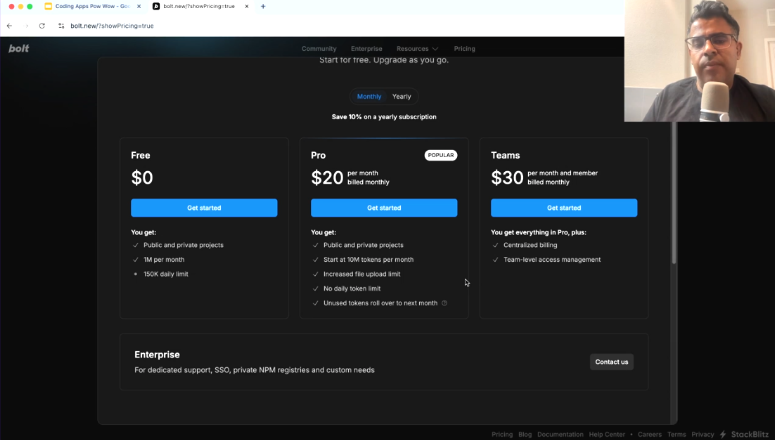
Packaging (7/10): Bolt offers Free, Pro ($20/month), and Teams ($30/month) plans, plus Enterprise. They provide clear value in their free plan and good feature differentiation. However, the Teams plan feels more like "Pro with team management" rather than a truly differentiated offering for team workflows.
Pricing Metric (7/10): Bolt uses tokens as their AI pricing model metric, which aligns with standard LLM pricing. They start at 10 million tokens for Pro plans and allow unused tokens to roll over, a customer-friendly feature many competitors lack. The token-based approach requires less mental translation for users familiar with AI pricing models.
Price Points (7/10): The $20-$30 gap between Pro and Teams seems insufficient given the willingness-to-pay differential between individual users and teams. A more substantial price increase would better capture team value while improving feature differentiation.
Cursor: Great Plans, Poor Communication
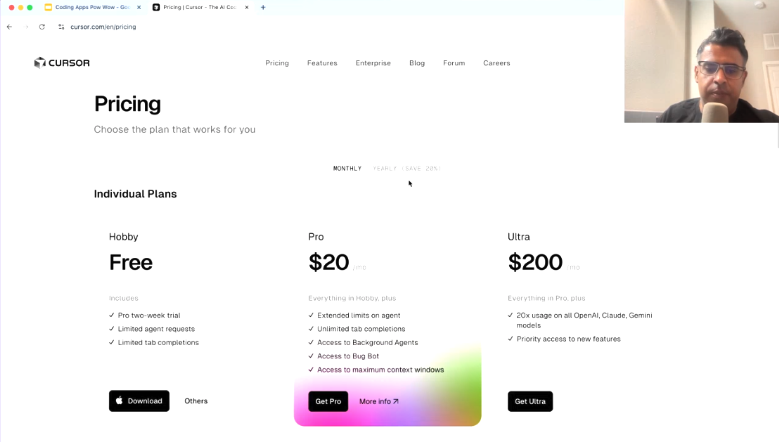
Packaging (9/10): Cursor shines with their plan structure: Free, Pro, Ultra, Teams, and Enterprise. The Ultra plan brilliantly solves the problem that both Lovable and Bold face, serious individual developers who need more than basic Pro but aren't part of a team. This addresses sales velocity issues effectively.
Pricing Metric (2/10): This is where Cursor stumbles badly. Their pricing page mentions "extended limits," "20x usage," and "$20 of usage per month" without explaining what "usage" actually means. They promise token breakdowns in the dashboard after purchase, exactly when customers need clarity before buying.
Price Points (8/10): Cursor's price point strategy aligns well with successful AI companies like Claude and OpenAI. The significant delta between Pro and Teams plans, plus the Ultra option, creates good revenue optimization opportunities.
Windsurf: The Clear Winner
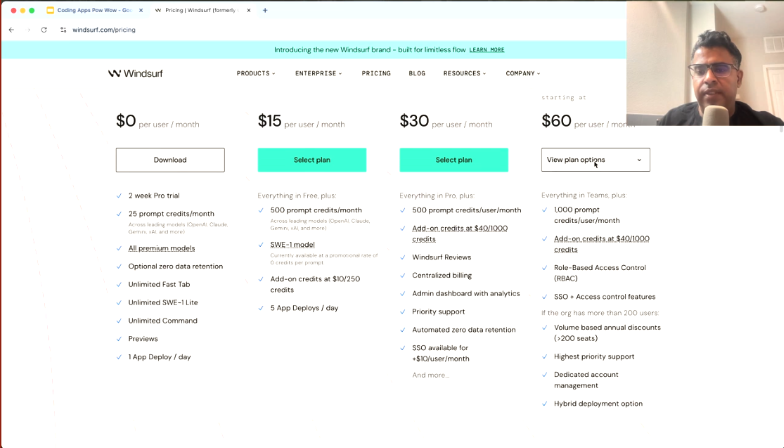
Packaging (7/10): Windsurf offers three main packages beyond free: per-user, per-month plans with clear enterprise features. While they understand enterprise needs better than most competitors, they could benefit from a true enterprise tier for organizations with 200+ users.
Pricing Metric (10/10): Windsurf excels here with "prompt credits" clearly explained with examples, credit multipliers for different models, and transparent overage fees. They provide exactly what customers need: clear understanding before purchase, not after.
Price Points (7/10): Solid price point strategy, though missing the ultra-high tier that could capture more revenue from premium individual users without forcing them into enterprise sales conversations.
Replit: Good Foundation, Needs Clarity
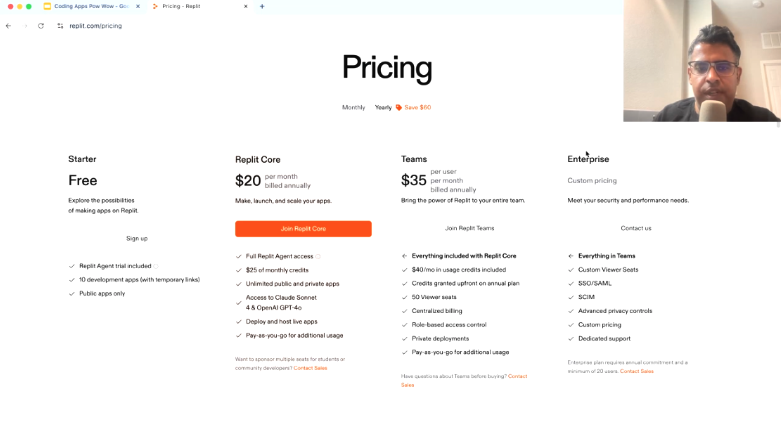
Packaging (9/10): Replit offers Replit Core, Teams, and Enterprise with comprehensive feature tables. They demonstrate better understanding of customer segments, properly routing team features to Teams tier and enterprise features to Enterprise tier.
Pricing Metric (5/10): While they mention "usage credits" and "pay-as-you-go for additional usage," the credits explanation is buried or missing from the pricing page. This creates confusion and reduces sales velocity.
Price Points (3/10): Missing a high-value individual tier similar to Cursor's Ultra plan. This forces premium individual users into enterprise sales conversations when they'd prefer to self-serve with a credit card.
The Final Verdict
Based on the comprehensive analysis of these SaaS pricing models across all three dimensions:
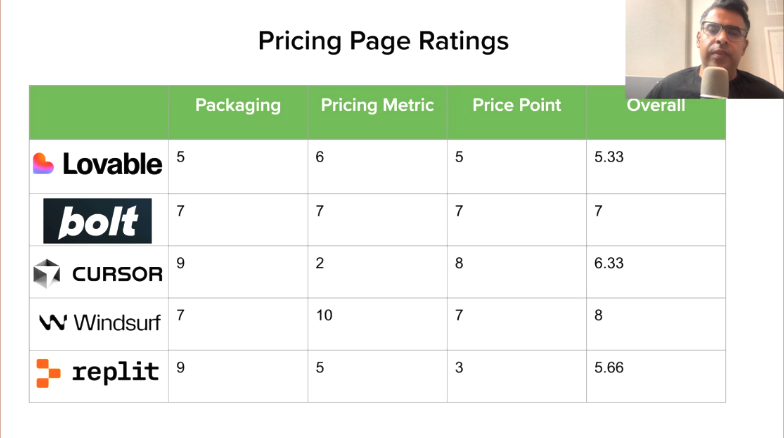
Winner: Windsurf (8.0/10 average) Windsurf takes the crown with the most well-designed, structured, and clear AI pricing strategy. Their transparent approach to pricing metrics, clear overage policies, and comprehensive explanations minimize customer confusion while maximizing revenue potential.
Runner-up: Cursor and Bold (tied at 7.3/10) Cursor would have won if they simply explained their pricing metric clearly, their package structure is excellent. Bold shows consistent performance across all areas with room for improvement in team plan differentiation.
Needs Improvement: Replit (5.7/10) and Lovable (5.3/10) Both companies leave significant money on the table through poor segmentation and unclear pricing communication. Lovable particularly struggles with limited plan options and pricing clarity.
Key Takeaways for AI Companies
- Clarity is king: Customers need to understand your AI pricing models before they buy, not after
- Segment properly: Don't force premium individual users into enterprise sales cycles
- Explain your metrics: Whether credits, tokens, or usage, make your SaaS pricing models crystal clear
- Plan for overages: Three-part tariff models need transparent overage policies
- Price for value: Serious users will pay premium prices for premium value
The AI coding platform market is moving fast, but the companies that nail their SaaS pricing strategies early will capture disproportionate value as the market matures. Windsurf shows that clear, customer-friendly AI pricing models can be a significant competitive advantage, even more important than having the fastest growth metrics.
.png)

